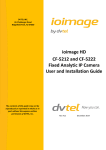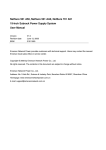Download DVTELL Ioimage trk-101 Installation manual
Transcript
DVTEL INC. 65 Challenger Road Ridgefield Park, NJ 07660 trk-101-P PTZ Tracker Installation Manual The contents of this manual may not The contents of this guide may be reproduced or reprinted in whole not be reproduced or reprinted or in part without the express written in whole or in part without the permission of DVTEL, INC. express written permission of DVTEL, INC. Rev 1 February 2015 Table of Contents Table of Contents 1. Document Information.............................................................................................. iii 2. Introduction .............................................................................................................. 1 2.1 Items Included in the Package .................................................................................. 2 2.2 Hardware Description ............................................................................................... 2 2.2.1 Power Connection Panel....................................................................................... 2 2.2.2 Video Connection Panel........................................................................................ 4 3. Installing and Connecting the Unit .............................................................................. 5 3.1 Installing the Unit ...................................................................................................... 5 3.1.1 Assembling the Unit in a Rack Mount Panel (Optional Accessory) ...................... 5 3.2 Connecting the Unit .................................................................................................. 7 3.2.1 Grounding the Unit ............................................................................................... 7 3.2.2 Connecting the Unit to the Power Supply ............................................................ 7 3.2.3 Using the DNA Utility to Connect the Unit to the Network.................................. 8 3.2.4 Connecting the Video Source (Camera) to the Unit ...........................................11 3.2.5 Configuring PTZ Camera Settings on the Encoder ..............................................12 3.2.6 Connecting the Analog Video Output to an Analog Device ................................12 3.2.7 Connecting the Unit to Receive Alarms from External Devices (Alarm Inputs)..13 3.2.8 Connecting the Unit to Control an External Device (Using Relay Outputs) ........13 3.3 Resetting the Unit ...................................................................................................14 3.3.1 Reset Using the RESET Button ............................................................................14 3.3.2 Reset by Removing the Power Supply ................................................................15 Appendix ............................................................................................................................16 A.1. Technical Specifications ..........................................................................................17 A.2. Connecting Leads to a Spring Clamp Terminal Block ..............................................19 A.3. Troubleshooting ......................................................................................................20 A.4. N/O to N/C Relay Configuration..............................................................................22 Contacting DVTEL ........................................................................................................... 23 i trk-101-P Installation Manual List of Figures Figure 1: trk-101-P Unit .............................................................................................................. 1 Figure 2: trk-101-P Unit Connectivity.......................................................................................... 1 Figure 3: trk-101-P Power Connection Panel ............................................................................. 2 Figure 4: trk-101-P Video Connection Panel .............................................................................. 4 Figure 5: trk-101-P with Nuts Removed ..................................................................................... 6 Figure 6: Inserting Units into Rack Mount Panel ........................................................................ 6 Figure 7: DNA Discovery Window .............................................................................................. 9 Figure 8: DNA Assign IP – Use DHCP Dialog Box .................................................................... 9 Figure 9: DNA Assign IP – Static IP Dialog Box .......................................................................10 Figure 10: Login Window ..........................................................................................................10 Figure 11: Web Interface Streaming Window ...........................................................................11 Figure 12: Camera > Type & Model Screen .............................................................................12 Figure 13: Relay Contacts Schematic ......................................................................................14 Figure 14: Spring Clamp Terminal Block ..................................................................................19 Figure 15: Connecting a Wire to a Terminal Block ...................................................................19 ii Document Information 1. Document Information Document Conventions Conventions relatives au document WARNING and CAUTION notes are distributed throughout this document, whenever applicable, to alert you of potentially hazardous situations. These may be hazards associated with a task or a procedure you are carrying out or are about to carry out. Les remarques AVERTISSEMENT et ATTENTION sont réparties dans l'ensemble du document, en fonction des besoins, afin de vous avertir des situations potentiellement dangereuses. Il peut s'agir de risques associés à une tâche ou à une procédure que vous effectuez ou êtes sur le point d'effectuer. The following document conventions are used throughout this manual: Les conventions suivantes sont utilisées dans l'ensemble du document: A Warning is a precautionary message that indicates a procedure or condition where there are potential hazards of personal injury or death. Avertissement est un message préventif indiquant qu'une procédure ou condition présente un risque potentiel de blessure ou de mort. A Caution is a precautionary message that indicates a procedure or condition where there are potential hazards of permanent damage to the equipment and or loss of data. Attention est un message préventif indiquant qu'une procédure ou condition présente un risque potentiel de dommages permanents pour l'équipement et/ou de perte de données. A Note is useful information to prevent problems, help with successful installation, or to provide additional understanding of the products and installation. Une Remarque est une information utile permettant d'éviter certains problèmes, d'effectuer une installation correcte ou de mieux comprendre les produits et l'installation. A Tip is information and best practices that are useful or provide some benefit for installation and use of DVTEL products. Un Conseil correspond à une information et aux bonnes pratiques utiles ou apportant un avantage supplémentaire pour l'installation et l'utilisation des produits DVTEL. iii trk-101-P Installation Manual Document Scope and Purpose The purpose of this document is to provide instructions and installation procedures for physically connecting the trk-101-P unit. After completing the physical installation, additional setup and configurations are required before video analysis and detection can commence. For information on the unit setup and configuration, refer to the HTML Edition Units User’s Guide. Note: This document is intended for use by technical users who have a basic understanding of CCTV camera/video equipment and LAN/WAN network connections. Remarque: Ce document est destiné aux utilisateurs techniciens qui possèdent des connaissances de base des équipements vidéo/caméras de télésurveillance et des connexions aux réseaux LAN/WAN. Warning: Installation must follow safety, standards, and electrical codes as well as the laws that apply where the units are being installed. Avertissement: L'installation doit respecter les consignes de sécurité, les normes et les codes électriques, ainsi que la législation en vigueur sur le lieu d'implantation des unités. Proprietary Rights and Non-Disclosure This manual is delivered subject to the following restrictions and conditions: This document contains proprietary information belonging to DVTEL, Inc. This information is supplied solely for the purpose of assisting explicitly the licensee of the DVTEL units. No part of this document contents may be used for any other purpose, disclosed to any third party or reproduced by any means, electronic or mechanical, without the express prior written permission of DVTEL, Inc. Trademarks and Copyrights DVTEL, the DVTEL logo, ioimage, the ioimage logo, ioimage analytics, ioibox, ioicam, ioimage HD, ioimage IP, ioimage Thermal, and Site Viewer are trademarks of DVTEL, Inc. Products and trademarks mentioned herein are for identification purposes only and may be registered trademarks of their respective companies. DVTEL, Inc. makes no representations whatsoever about any other products or trademarks mentioned in the manual. This manual and its contents herein are owned by DVTEL, Inc. © DVTEL, Inc. 2015. All rights reserved. iv Document Information Disclaimer Avis de non-responsabilité Users of DVTEL products accept full responsibility for ensuring the suitability and considering the role of the product detection capabilities and their limitation as they apply to their unique site requirements. Il incombe aux utilisateurs des produits DVTEL de vérifier que ces produits sont adaptés et d'étudier le rôle des capacités et limites de détection du produit appliqués aux exigences uniques de leur site. DVTEL, Inc. and its agents make no guarantees or warranties to the suitability for the users’ intended use. DVTEL, Inc. accepts no responsibility for improper use or incomplete security and safety measures. DVTEL, Inc. et ses agents ne garantissent d'aucune façon que les produits sont adaptés à l'usage auquel l'utilisateur les destine. DVTEL, Inc. ne pourra être tenu pour responsable en cas de mauvaise utilisation ou de mise en place de mesures de sécurité insuffisantes. Failure in part or in whole of the installer, owner, or user in any way to follow the prescribed procedures or to heed WARNINGS and CAUTIONS shall absolve DVTEL, Inc. and its agents from any resulting liability. Le non respect de tout ou partie des procédures recommandées ou des messages d'AVERTISSEMENT ou d'ATTENTION de la part de l'installateur, du propriétaire ou de l'utilisateur dégagera DVTEL, Inc. et ses agents de toute responsabilité en résultant. Specifications and information in this guide are subject to change without notice. Les spécifications et informations contenues dans ce guide sont sujettes à modification sans préavis. General Cautions and Warnings Précautions et avertissements d'ordre général This section contains information that indicates a procedure or condition where there are potential hazards. SAVE ALL SAFETY AND OPERATING INSTRUCTIONS FOR FUTURE USE. Cette section contient des informations indiquant qu'une procédure ou condition présente des risques potentiels. CONSERVEZ TOUTES LES INSTRUCTIONS DE SÉCURITÉ ET D'UTILISATION POUR POUVOIR VOUS Although the unit is designed and manufactured in Y RÉFÉRER ULTÉRIEUREMENT. compliance with all applicable safety standards, Bien que l'unité soit conçue et fabriquée certain hazards are present during the installation conformément à toutes les normes de sécurité en of this equipment. vigueur, l'installation de cet équipement présente certains risques. To help ensure safety and to help reduce risk of Afin de garantir la sécurité et de réduire les risques injury or damage, observe the following: de blessure ou de dommages, veuillez respecter les consignes suivantes: v trk-101-P Installation Manual Warning: 1. The unit’s cover is an essential part of the product. Do not open or remove it. 2. Never operate the unit without the cover in place. Operating the unit without the cover poses a risk of fire and shock hazards. 3. Do not disassemble the unit or remove screws. There are no user serviceable parts inside the unit. 4. Only qualified trained personnel should service and repair this equipment. 5. Observe local codes and laws and ensure that installation and operation are in accordance with fire, security and safety standards. Avertissement: 1. Le cache de l'unité est une partie essentielle du produit. Ne les ouvrez et ne les retirez pas. 2. N'utilisez jamais l'unité sans que le cache soit en place. L'utilisation de l'unité sans cache présente un risque d'incendie et de choc électrique. 3. Ne démontez pas l'unité et ne retirez pas ses vis. Aucune pièce se trouvant à l'intérieur de l'unité ne nécessite un entretien par l'utilisateur. 4. Seul un technicien formé et qualifié est autorisé à entretenir et à réparer cet équipement. 5. Respectez les codes et réglementations locaux, et assurez-vous que l'installation et l'utilisation sont conformes aux normes contre l'incendie et de sécurité. Caution: To avoid damage from overheating or unit failure, assure that there is sufficient temperature regulation to support the unit’s requirements (cooling/heating). Operating temperature should be kept in the range specified for the product (0° to 60°C/32° to 140°F), with no more than 95% non-condensing humidity. Attention: Afin d'éviter tout dommage dû à une surchauffe ou toute panne de l'unité, assurez-vous que la régulation de température est suffisante pour répondre aux exigences de l'unité (refroidissement/chauffage). La température de fonctionnement doit être maintenue dans la plage de température spécifiée pour le produit (0° à 60°C/32° à 140°F), sans condensation d'humidité supérieur à 95%. vi Document Information Electrical Safety Notice and Warnings Warning: 1. Read the installation instructions before you connect the unit to a power source. 2. Electrical safety should always be observed. All electrical connections must be performed by a certified electrician. 3. Use the supplied power supply and protect against static electricity, ground faults and power surges. 4. The unit uses a three-wire power cord to make sure that the product is properly grounded when in use. This is a safety feature. If the intended power outlet does not support three prongs, one of which is a ground, contact an electrician to install the appropriate outlet. NEVER remove or otherwise attempt to bypass the ground pin of the power cord. Do not operate the unit in the absence of a suitably installed ground conductor. 5. If you use an extension cord with this system, make sure that the total ampere rating on the products plugged into the extension cord does not exceed the extension cord ampere rating. 6. To avoid possible shock hazards or damaging the unit, assure that the positive and negative of the power leads are properly connected to the terminal block connector before plugging it into the unit or turning on the power source. 7. In the following situations, the electric power should be turned off immediately and appropriate repairs, replacements or remedies should be taken if: The power line is damaged, frayed or shows heavy wear. The unit has been physically crushed or deformed. The unit has been exposed to water. The unit has been exposed to, or shows signs of damage from, fire, intense heat, heavy smoke, fumes, or vapors. Electrical connections of the unit become abnormally hot or generate smoke. The unit has been dropped, damaged or shows signs of loose internal parts. The unit does not operate properly. vii trk-101-P Installation Manual Avis et avertissements relatifs à la sécurité électrique Avertissement: 1. Lisez les instructions d'installation avant de brancher l'unité à une source d'alimentation électrique. 2. Les consignes de sécurité électrique doivent toujours être respectées. Toutes les connexions électriques doivent être effectuées par un électricien qualifié. 3. Utilisez l'alimentation fournie, et protégez l'unité contre l'électricité statique, les défauts de mise à la terre et les surtensions. 4. Si l'unité utilise un cordon d'alimentation à trois fils, assurez-vous que le produit est correctement mis à la terre du produit lors de son utilisation. Ne retirez JAMAIS, et ne tentez pas de contourner la broche de mise à la terre du cordon d'alimentation. N'utilisez pas l'unité en l'absence d'un conducteur de mise à la terre installé correctement. 5. Si vous utilisez une rallonge avec ce système, assurez-vous que l'ampérage total des produits branchés sur la rallonge ne dépasse pas l'ampérage nominal de celle-ci. 6. Pour éviter tout risque de choc électrique ou d'endommager l'unité, assurez-vous que les bornes plus et moins de l'alimentation sont correctement raccordées au connecteur du bloc de jonction avant de le brancher sur l'unité ou d'activer la source d'alimentation. 7. Dans les situations suivantes, l'alimentation électrique doit être coupée immédiatement, et les réparations, remplacements ou solutions suivants doivent être effectués si : viii Le cordon d'alimentation ou la prise (le cas échéant) est endommagé, effiloché ou très usé. L'unité a subi un choc ou a été déformée. L'unité a été exposée à de l'eau. L'unité a été exposée à, ou montre des signes de dégâts par le feu, une chaleur intense, une fumée épaisse, des émanations ou des vapeurs. Les connexions électriques chauffent de façon anormale ou produisent de la fumée. L'unité est tombée, a été endommagée, ou certaines pièces internes semblent détachées. L'unité ne fonctionne pas correctement. Document Information Minimizing EMI and RFI Minimisation des IEM et des IRF When wires run for a significant distance in an electromagnetic field, electromagnetic interference (EMI) can occur. Strong EMI (e.g. lightning or radio transmitters) can destroy the units and can pose an electrical hazard by conducting power through lines and into the system. Poor quality or worn wiring can result in radio frequency interference (RFI). To minimize the effects of EMI and RFI, consult your reseller. Lorsque des câbles parcourent une distance importante dans un champ électromagnétique, des interférences électromagnétiques (IEM) peuvent se produire. D'importantes IEM (comme la foudre ou un émetteur radio) peuvent détruire les unités et présenter un risque électrique si elles se propagent sur les câbles et dans le système. Des câbles de mauvaise qualité ou usés peuvent provoquer des interférences radioélectriques (IRF). Pour minimiser les effets des IEM et des IRF, consultez votre revendeur. Site Preparation There are several requirements that should be properly addressed prior to installation at the site. The following specifications are requirements for proper installation and operation of the unit: Ambient Environment Conditions: Avoid positioning the unit near heaters or heating system outputs. Avoid exposure to direct sunlight. Use proper maintenance to ensure that the unit is free from dust, dirt, smoke, particles, chemicals, smoke, water or water condensation, and exposure to EMI. Accessibility: The location used should allow easy access to unit connections and cables. Safety: Cables and electrical cords should be routed in a manner that prevents safety hazards, such as from tripping, wire fraying, overheating, etc. Ensure that nothing rests on the unit’s cables or power cords. Ample Air Circulation: Leave enough space around the unit to allow free air circulation. Cabling Considerations: Units should be placed in locations that are optimal for the type of video cabling used between the unit and the cameras and external devices. Using a cable longer than the manufacturer’s specifications for optimal video signal may result in degradation of color and video parameters. Physical Security: The unit provides threat detection for physical security systems. In order to ensure that the unit cannot be disabled or tampered with, the system should be installed with security measures regarding physical access by trusted and un-trusted parties. Network Security: The unit transmits over IP to security personnel for video surveillance. Proper network security measures should be in place to assure networks remain operating and free from malicious interference. The unit is intended for installation on the backbone of a trusted network. Electrostatic Safeguards: The unit as well as other equipment connected to it (relay outputs, alarm inputs, racks, carpeting, etc.) shall be properly grounded to prevent electrostatic discharge. The physical installation of the unit is the first phase of making the unit operational in a security plan. The goal is to physically place the unit, connect it to other devices in the system, and to establish network connectivity. When finished with the physical installation, refer to the HTML Edition Units User’s Guide to complete the second phase of installation, which is the setup and configuration of the unit. ix Introduction 2. Introduction The trk-101-P PTZ Tracker is a single-channel, self-contained H.264 IP video analytic encoder that is designed to control and monitor the video input from an analog PTZ camera. Once a moving object has been detected, the unit controls and moves the PTZ camera to autonomously track and zoom in on the threat. The unit provides alarms when it automatically detects specific events, such as region entrance, fence trespassing, tripwire crossover, which trigger an automatic notification. You can define the events and location in the video of the image that can be detected with user-customizable rules and positioning criteria. Figure 1: trk-101-P Unit In addition to its analytic capabilities, the unit also serves as a standard video encoder that digitizes the input video to a standards-compliant, compressed IP video stream. It simultaneously provides video output in two formats: analog video and compressed digital video over IP. On-screen overlays indicate where the detection has occurred on the video output. Figure 2: trk-101-P Unit Connectivity This chapter includes the following sections: Items Included in the Package (page 2) Hardware Description (page 2) 1 trk-101-P Installation Manual 2.1 Items Included in the Package The unit package contains the following items: QTY Description 1 trk-101-P PTZ Tracker 1 Mounting bracket 1 Set of spring clamp terminal blocks 1 Documentation and utilities CD Related Documentation: HTML Edition Units User’s Guide ioi Product Selection Matrix trk-101 and trk-101-P Quick Install Guide DNA 2.0 User Manual 2.2 Hardware Description This section describes the connection panels of the unit. 2.2.1 Power Connection Panel The following is a description of the power connection panel of the unit. Figure 3: trk-101-P Power Connection Panel The power connection panel of the unit includes the following connections: 2 Item Description Grounding Terminal For connecting the unit to the protective ground (earth) according to local regulations and codes. For more information, see Grounding the Unit (page 7). Power Source Input Terminal block for powering the unit from a 12VDC or 24VAC power source. ETHERNET Port RJ45 connector for connecting the unit to the Ethernet network (10/100 Mbps). ALARM IN Single alarm input connection (a set of two wires) from an external device — for example, a fire sensor, PIR (passive infrared) sensor, fence sensor, etc. — with a dry contact output to the terminal block. RELAY OUT (N.O.) Dry output contact signal to a single external device, such as an electrical door lock, to the terminal block. The terminal is for NORMALLY OPEN configuration. Introduction Item Description RESET Button For setting the unit factory defaults, setting Technician mode, or resetting the unit. LEDs The LEDs indicates several status conditions: Off: The unit is resetting. Flashing green (300ms intervals): The firmware is booting. Flashing green (one second intervals): The firmware has booted successfully, the encoder is connected to the network, and unit is operating normally. Steady red: Failure in the first phase of the boot. Requires resetting the unit. Flashing red: Failure in the second phase of the boot. Requires resetting the unit. Steady yellow: Reset button was pressed for 5-15 seconds and entered Technician mode. Requires resetting the unit. Flashing yellow (500ms intervals): The unit is in Factory Default mode. To enter this mode, press the Reset button for 15-30 seconds. The LED changes from steady state to flashing after five seconds. The unit’s firmware returns to the factory defaults. When finished, the LED displays flashing green. Note: If the LED is pressed for more than 30 seconds, it will flash red, indicating an error. In this case, disconnect the unit and reboot. TR+/TRRS485 Two-pin terminal block connector to connect an RS-485 cable from and control a PTZ camera. 3 trk-101-P Installation Manual 2.2.2 Video Connection Panel The following is a description of the video connection panel of the unit. Figure 4: trk-101-P Video Connection Panel The video connection panel of the unit includes the following items: Item Description VIDEO OUT (BNC) Output interface that provides the analog video signal after analysis and includes detection overlays and additional On-Screen Display (OSD) information. Typically connected to analog video equipment such as analog video displays or analog video recording device or digital video recorder (DVR). Note: In order to view analog video, analog Video Out must be enabled in the unit settings (disabled by default). For more information on how to enable the analog Video Out signal, refer to the HTML Edition Units User’s Guide. VIDEO IN (BNC) 4 Input interface for receiving the surveillance camera analog video signal (source) for analysis and detection. Installing and Connecting the Unit 3. Installing and Connecting the Unit This section describes how to install and connect the unit and includes the following sections: Installing the Unit (page 5) Connecting the Unit (page 7) Resetting the Unit (page 14) Note: After connecting the unit, proceed to configure the unit as described in the HTML Edition Units User’s Guide. 3.1 Installing the Unit The unit can be installed and mounted next to the camera (inside the camera enclosure). Alternatively, the unit can be installed inside an equipment room on a shelf or in a rack using the rack mount panel that is available as an optional accessory. When installing the unit make sure that: It is securely tied down and cannot be easily dislodged Operating temperatures, at all times, are kept between the minimum/maximum allowed Proper ventilation is provided so that the air is free to circulate around the unit The unit is protected from direct weather conditions (for example, sunlight, rain, dust, and so on) Caution: To avoid damage from overheating or unit failure, assure that there is sufficient temperature regulation to support the unit’s requirements (cooling/heating). Operating temperature should be kept in the range specified for the product (0° to 60°C/32° to 140°F), with no more than 95% non-condensing humidity. Attention: Afin d'éviter tout dommage dû à une surchauffe ou toute panne de l'unité, assurez-vous que la régulation de température est suffisante pour répondre aux exigences de l'unité (refroidissement/chauffage). La température de fonctionnement doit être maintenue dans la plage de température spécifiée pour le produit (0° à 60°C/32° à 140°F), sans condensation d'humidité supérieur à 95%. 3.1.1 Assembling the Unit in a Rack Mount Panel (Optional Accessory) Up to 10 units can be mounted on a single rack mount panel. After the units have been assembled in the rack mount panel, the panel can be installed in a standard 19-inch rack. 5 trk-101-P Installation Manual To assemble units in a rack mount panel: 1. Remove the nut and washer from each of the two video connectors on the video connection panel of the unit. Figure 5: trk-101-P with Nuts Removed 2. Attach each unit to the rear side of the rack mount panel by inserting it through the holes as shown in Figure 6. Figure 6: Inserting Units into Rack Mount Panel 3. Fasten each unit using the nuts and washers removed in step 1, making sure to first place the washer on each video connector before tightening the nut on the video connector. 4. Repeat steps 1 through 3 for each of the units you want to assemble on the rack mount panel (up to 10 units can be assembled per panel). 5. Attach the rack mount panel to a 19" rack. 6 Installing and Connecting the Unit 3.2 Connecting the Unit This section describes the procedures for connecting the unit and includes the following sub-sections: Grounding the Unit (page 7) Connecting the Unit to the Power Supply (page 7) Using the DNA Utility to Connect the Unit to the Network (page 8) Connecting the Video Source (Camera) to the Unit (page 11) Connecting the Analog Video Output to an Analog Device (page 12) Connecting the Unit to Receive Alarms from External Devices (Alarm Inputs) (page 13) Connecting the Unit to Control an External Device (Using Relay Outputs) (page 13) 3.2.1 Grounding the Unit The unit must be grounded according to local regulations and codes. To ground the unit 1. Loosen the screw of the grounding terminal located on the power connection panel of the unit. See Figure 3: trk-101-P Power Connection Panel. 2. Attach a properly rated ground cable. Make sure the ring/spade terminal of the grounding cable is between the toothed washers. Tighten the screw. 3. Ensure that the other end of the ground cable is connected to protective earth according to local regulations and codes. 3.2.2 Connecting the Unit to the Power Supply Before connecting to the power, review the Electrical Safety and Notice Warning (page vii). Use a 12VDC/24VAC external power supply with suitable over current protection. Connect the power supply wires to the positive and negative inputs on the terminal block connector labeled 12VDC/24VAC. See Power Connection Panel (page 2). Following are the recommended AC adaptor specifications: Power Adaptor Input: 110-240V, 47-63Hz, 1A Power Adaptor Output: 12VDC, 2A, 24W To power to the unit using a power outlet 1. Connect the AC adaptor output to the terminal block on the power connection panel of the unit. 2. Connect the AC adaptor to the power outlet. 7 trk-101-P Installation Manual Warning: 1. To prevent bodily injury or damage to the unit, use only properly rated and approved power supplies and/or AC adaptors. 2. Make sure that the power supply matches the required specifications. Electrical safety should always be observed. Avertissement: 1. Pour prévenir toute blessure corporelle ou tout endommagement de l'unité, n'utilisez que des alimentations et/ou des adaptateurs secteur correctement classifiés et approuvés. 2. Assurez-vous que l'alimentation corresponde aux spécifications requises. Les consignes de sécurité électrique doivent toujours être respectées. 3.2.3 Using the DNA Utility to Connect the Unit to the Network By default, the unit is shipped with the factory default IP address 192.168.123.10. The DVTEL Network Assistant (DNA) utility is used to discover the unit on the network and to configure it. DNA provides a central location for listing all the DVTEL models accessible over the network. Once listed, each camera or encoder can be right-clicked to access and change the network settings. If the network settings are changed for some reason, a new search will relist the units. The units may then be configured via the web interface. If DVTEL Latitude is being used, configure the unit with a static IP address rather than with DHCP. This ensures that the IP address will not automatically change in the future and interfere with configurations and communication. DNA has a simple user interface and does not require any installation. The software is provided as a single, standalone executable that runs on any PC. Note: Before connecting the unit to the network, set the unit IP address according to your specific network requirements to avoid address conflicts. Refer to the instructions in this section on how to change the unit’s IP addresses. If your network uses firewalls, you must configure them to support communication among the units and computers running the Internet browser used to connect to the trk-101-P web interface. After connecting the unit to the network, check that the unit can be found on the network as is described below. To connect a unit to the network 1. Connect a PC/laptop directly to the unit using a network cable connected to the Ethernet port located on the front panel of the unit. See Figure 3: trk-101-P Power Connection Panel (page 2). 2. Change the IP address according to your specific requirements. See the following section. 3. Disconnect the unit from your PC/laptop. 4. Connect the unit to the system network as follows: Connect the network cable to the Ethernet port located on the front panel of the unit. See Figure 3: trk-101-P Power Connection Panel (page 2). Connect the other network cable end to the network switch/hub. 8 Installing and Connecting the Unit To change the unit’s IP address 1. Insert the CD included in the package in your computer’s disk drive. Note: The PC and the unit must be physically connected on the same subnet. 2. Run the dna.exe file by clicking the displayed in the window. 3. Select the unit by right-clicking on it. icon. The DNA application opens and the device is Figure 7: DNA Discovery Window 4. If there are devices located on a separate VLAN, click add them manually. 5. Select the unit by right-clicking on it and click Assign IP The Assign IP dialog box opens. on the DNA toolbar to or select the Assign IP option. Figure 8: DNA Assign IP – Use DHCP Dialog Box 9 trk-101-P Installation Manual 6. For each unit, do one of the following: If your network uses a DHCP server: i. Select Use DHCP. ii. Click Update. A new IP address is automatically assigned to the selected device(s) by the network DHCP server. If your network uses Latitude: i. Set a static IP address. ii. Do not select the Use DHCP checkbox. iii. In the IP Address, Gateway, and Mask, enter the respective LAN/VLAN (optional DNS) values. Figure 9: DNA Assign IP – Static IP Dialog Box iv. Click Update and wait for OK status to be displayed. 7. Repeat Step 5 for each unit. 8. Select the Web icon from the DNA navigation bar or right-click Web. 9. Enter the unit’s IP address in your browser. 10. When the unit’s Login window opens, enter the default user name (“admin”) and password (“admin”). The unit’s user interface opens. Figure 10: Login Window Note: User name and password are case-sensitive. 10 Installing and Connecting the Unit 3.2.4 Connecting the Video Source (Camera) to the Unit The unit is designed to accept a composite video signal (1Vp-p) from an analog PTZ camera. Video connections should use a 75Ω cable and should not be longer than 30 meters (98 feet). To connect the video source to the unit 1. Securely connect the video cable BNC connector to the analog video output of the camera or video source. 2. Connect the other cable end to the VIDEO IN connection on the video connection panel of the unit. See Figure 4: trk-101-P Video Connection Panel (page 4). To set the unit’s video standard via its web interface 1. Enter the IP address of the unit in a browser. The unit’s Login window opens. 2. Login to the unit by entering your user name and password. The default user name and password are both “admin”. The web interface opens. 3. If your computer requires ActiveX installation, install it now. 4. From the Live View window, access the Camera Setup by clicking Setup > Camera > Streaming. The Streaming window opens. Figure 11: Web Interface Streaming Window 5. In the Video Standard field, select PAL or NTSC. 6. Click Apply to save the setting. Note: If the video standard is changed, all analytic settings will be deleted. 11 trk-101-P Installation Manual 3.2.5 Configuring PTZ Camera Settings on the Encoder PTZ camera settings are configured in the Setup > Camera > Type & Model screen in the web interface. Figure 12: Camera > Type & Model Screen To configure PTZ camera settings on the encoder 1. In the Camera Type area, select Pan/Tilt/Zoom (PTZ). 2. Check Enable Re-arm. 3. From the Re-arm Duration drop-down list, select the number of seconds until the unit automatically rearms itself after being operated manually. 4. In the Camera Model section, from the drop-down lists, select the camera manufacturer, model number, and maximum zoom. 5. In the Communication section, from the drop-down lists, select the details for the following settings: Device ID Baud rate Parity Start bits Stop bits 6. Click Start PTZ Setup to run the wizard to configure PTZ settings. For more information, see section 5.3.1.2.1.1 in the HTML Edition Units User’s Guide. 7. When completed, click Apply to save settings. 3.2.6 Connecting the Analog Video Output to an Analog Device Note: The analog video output signal of the unit is disabled by default. Enable it if necessary using the unit’s web interface. The analog video output (composite video) contains the video from the camera combined with On-Screen Display (OSD) overlays such as detected objects, tracking boxes and trails, time stamp, alarm, camera status, and so on. These OSDs can be enabled and customized using the unit embedded HTML user interface. The analog video output can be monitored using an analog monitor or recorded on a digital video recorder (DVR). For more information, refer to the HTML Edition Units User’s Guide. 12 Installing and Connecting the Unit To connect the unit analog video output to an analog device Using video coax 75Ω cable with BNC connectors, connect the VIDEO OUT of the ioimage unit to the analog device Video Input (for example, the VIDEO IN of a monitor or DVR). Note: Make sure the ioimage unit and the external analog equipment support the same video standard (PAL/NTSC). 3.2.7 Connecting the Unit to Receive Alarms from External Devices (Alarm Inputs) The unit supports receiving alarms from external devices such as sensors and doors, enabling it to trigger automatic responses on the unit. The unit supports a single alarm input from an external device. The alarm input includes two connecting terminals. Warning: Only dry contacts can be connected to the unit’s ALARM IN terminals. An external device must fully close or fully open the circuit between the unit’s ALARM IN terminals. Avertissement: Seuls des contacts secs peuvent être branchés aux terminaux ALARM IN de l'unité. Un appareil externe doit complètement ouvrir ou complètement fermer le circuit entre les terminaux ALARM IN de l'unité. To connect an external alarm to the unit Warning: Disconnect power from the unit before performing the following procedure. Avertissement: Débranchez l'alimentation de l'unité avant d'effectuer la procédure suivante. 1. Connect the leads from the external device dry contact output using the spring clamp terminal block into the terminals marked ALARM IN (-) and (+). See Connecting Leads to a Spring Clamp Terminal Block (page 19). The two terminals are located at the bottom of the terminal block. See Figure 3: trk-101-P Power Connection Panel (page 2). 2. Connect the terminal block to the external devices connector on the power connection panel of the unit. See Figure 3: trk-101-P Power Connection Panel (page 2). 3. Connect the other end of the cable to the alarm out (dry contact) of the alarm device/sensor. 3.2.8 Connecting the Unit to Control an External Device (Using Relay Outputs) You can use the relay output of the unit to provide an indication signal for controlling external devices, such as door locks, lights, etc. The relay output of the unit can be activated as a response to events and alerts. For more information on incident responses and relay outputs, refer to the HTML Edition Units User’s Guide. Warning: The signal from the relay output of the unit must be used as an indicator and not for direct control of a device. Avertissement: Le signal provenant de la sortie relais de l'unité doit être utilisé comme indicateur et non pas pour contrôler directement un appareil. 13 trk-101-P Installation Manual Caution: To prevent damage to the unit, do not exceed the voltage and current ratings for the relay terminals. Attention: Pour prévenir tout endommagement de l'unité, ne dépassez pas les valeurs de courant et de tension pour les terminaux relais. Relay Output Specifications Maximum current 1A @ 30VDC Relay Contacts Schematics Figure 13: Relay Contacts Schematic The input supports opto-isolated signal for a single external device. Signals can be sent as continuous (ON/OFF) or single pulse of predefined duration. Note: It is also possible to configure the relay for a NORMALLY CLOSED (N/C) condition. See N/O to N/C Relay Configuration (page 22) in the Appendix for details. To connect a device controller to a relay output of the unit 1. Connect the leads from the external device controller to the respective terminal points on the spring clamp terminal block according to your requirements (NORMALLY OPEN or NORMALLY CLOSED configuration). See Connecting Leads to a Spring Clamp Terminal Block (page 19). The three terminal points for the relay output are located at the bottom left of the terminal block. See Figure 3: trk-101-P Power Connection Panel (page 2). 2. Connect the terminal block to the external devices connector on the power connection panel of the unit. See Figure 3: trk-101-P Power Connection Panel (page 2). 3. Connect the other end of the cable to the external controller, which receives the signal from the unit and controls/powers the external device. 3.3 Resetting the Unit The unit can be reset as follows: Reset Using the RESET Button (page 14) Reset by Removing the Power Supply (page 15) 3.3.1 Reset Using the RESET Button The unit has a reset button located on the power connection panel of the unit. See Figure 3: trk-101-P Power Connection Panel (page 2). To reset a unit using the RESET button 1. Insert a small pointed object into the hole labeled RESET on the power connection panel of the unit. 2. Press in and release the button within 5 seconds. The unit resets to its last settings and the LED flashes green. 14 Installing and Connecting the Unit 3.3.2 Reset by Removing the Power Supply The unit can be reset by turning off the power and then turning it on again. To reset a unit by removing the power supply 1. Turn off or disconnect the power to the unit. 2. Turn on or reconnect the power to the unit. The unit restarts with the last settings. 15 trk-101-P Installation Manual Appendix The appendix contains the following sections: 16 Technical Specifications (page 17) Connecting Leads to a Spring Clamp Terminal Block (page 19) Troubleshooting (page 20) NO to NC Relay Configuration (page 22) Appendix A.1. Technical Specifications Following are the trk-101-P technical specifications: Video Input Channels Number of Intelligent Video Analysis Channels 1 Analog Video Output TV Standard Composite 1Vp-p (PAL or NTSC) Physical Connector 1 x BNC 75Ω Digital Encoding IP Video Streaming H.264, MPEG 4 SP, and MJPEG Frame Rate (H.264) per Resolution D1 4CIF VGA 2CIF CIF 12/15 fps PAL/NTSC 12/15 fps PAL/NTSC 18 fps PAL/NTSC 25/30 fps PAL/NTSC 25/30 fps PAL/NTSC Frame Rate (MPEG 4 SP) Up to 25/30 fps (PAL/NTSC) for all resolutions Rate Control Option CBR (128Kbps – 4Mbps), VBR Storage on the Edge 3,800 Mb (475MB) event recording Network Ethernet (IEEE 802.3/802.3U) 1 x Ethernet RJ45 interface Services and Protocols TCP/IP, UDP/IP, HTTP, SMTP, DHCP, DNS, SNTP Video Streaming RTP/RTSP Alarms/Commands TCP/IP, HTTP Web Browsers Internet Explorer 8, 9, 10, and 11 Operating System Windows XP, 7, 8, and 8.1 I/O Interface Serial 1 x RS-485 for PTZ camera control Alarm Input 1 x dry contact Relay Output 1 x relay output (rated load 0.3A@ 12VDC, 0.25A@ 24VAC, 50/60Hz, and 1A@ 30VDC) Power Source Current Power Consumption 12 VDC 0.3A 3.6W 24 VAC 0.25A 6W 17 trk-101-P Installation Manual Physical Dimensions Dimensions (mm) 68.5 x 36 x 118 mm (W x H x D) Dimensions (in.) 2.7 x 1.42 x 4.62” (W x H x D) Environmental Specifications Operating Temperature 0° to 60°C (32° to 140°F) Operating Humidity 5% to 95% (non-condensing) Certifications 18 Safety UL 60950-1:2007; IEC 60950-1:2005 (Ed. 2) + A1:2009 + A2:2013; EN 60950-1:2006 (Ed. 2) + A11:2009 + A1: 2010 + A12:2011 + A2:2013; CAN/CSA-22.2 No. 60950-1-07 + A1:2011; cTUVus Electromagnetic Interference (EMC) FCC (47 CFR) Part 15 Subpart B, Class A; CE Class A; EN 55022 Class A; EN 55024; CISPR 22: 2009 Class A; VCCI; RCM Environmental RoHS Appendix A.2. Connecting Leads to a Spring Clamp Terminal Block The unit is delivered with two terminal block connectors. The connectors enable you to connect wires for either the Relay Output or Alarm Input and then connect them to the unit. Figure 14: Spring Clamp Terminal Block To connect a wire to the spring clamp terminal block: 1. Strip the insulation form the end of each wire that is to be connected to the terminal block. Approximately 1 cm (2.54”) of wire should be exposed. 2. With a small screwdriver, press in and hold the orange spring clamp button next to the female outlet where the wire will be inserted. 3. Insert the stripped end of the wire into the female outlet. 4. Release the orange spring clamp button. Figure 15: Connecting a Wire to a Terminal Block 19 trk-101-P Installation Manual A.3. Troubleshooting This section provides useful information and remedies for common situations where problems may be encountered. Problem Possible Solution No network connection Hardware issues: Check that the network is working and the unit is powered on. Check that the network (Ethernet) cable is properly attached to the unit. Confirm that the LED on the Ethernet (RJ45) connector on the power connection panel of the unit is on. Confirm that the network cables are not damaged and replace if necessary. IP Address issues: Change the default IP address/addresses of the unit. From the PC running the web browser, ping the unit IP address and confirm that it can be reached. Confirm that the network settings/firewalls are set according to the requirements. How do I find IP address of my unit? The IP address can be set via the unit’s DNA application. See Connecting the Unit to the Network. The IP address responds to a ping on the network from the workstation but does not show in the DNA application Disconnect the unit’s Ethernet 10/100 port or turn the power to unit off, and then ping the IP address again. If the IP address responds, there is another device using the IP address. Consult with your network administrator to resolve the conflict. The unit IP address is in use by another computer (collision) Change the unit IP address after connecting to it directly (not through the system network). See Connecting the Unit to the Network to set the IP address via the DNA application. No analog output video signal 20 Make sure the analog video out is enabled on the unit/channel. Refer to the HTML Edition Units User’s Guide for details. Check that the video cables are securely connected between the unit’s VIDEO OUT BNC connector and the analog video source. Check that the connection is made to the correct VIDEO OUT connector of the analog video source. Confirm that the camera has power. Check the cables for damage and replace as needed. Appendix Problem Bad output video quality Possible Solution Streaming video image is hanging (stopped) Alarm inputs are not working Relay outputs are not working Check the source video signal quality by connecting an analog monitor to the video source. If video quality is acceptable, connect the video source to the unit. Check that the cables are connected securely. This includes junction boxes and amplifier that may be used. Check that the camera settings are correct on the camera and in the unit. Refer to the HTML Edition Units User’s Guide for details. Check that the camera lens is clean and unobstructed. Check that the analog video signal is not being degraded due impedance caused by lengthy or worn cable, numerous connectors, ground loops interference, and so on. Check that the cable length is within specification. Confirm the unit’s video streaming settings. Refer to the HTML Edition Units User’s Guide for details. Refresh your browser screen (F5). Check that the bandwidth and bit rate settings of the network are set properly. Check that other processes and applications are not causing undue latency. Check that the firewall analysis or blocking is not interfering with the video stream and supports the required ports and communication protocols. Check the unit settings to confirm that the alarm input is enabled. Refer to the HTML Edition Units User’s Guide for details. Check that a proper rule for an alarm input event has been defined in the unit. Refer to the HTML Edition Units User’s Guide for details. Check that the alarm input (dry contact close/open) is being provided by the connected device. Check that the unit is communicating through the network. Check that the alarm input wires are connected securely. Check that the alarm wires are paired in the terminal block in the right positions and according to requirements. Check the unit settings to confirm that the relay output is enabled. Refer to the HTML Edition Units User’s Guide for details. Check that a proper rule for activating a relay output has been defined in the unit or activate it manually. Refer to the HTML Edition Units User’s Guide for details. Check the relay output wires are connected securely. Check that the relay output wires are paired in the terminal block according to requirements and that one wire is connected to the common. 21 trk-101-P Installation Manual A.4. N/O to N/C Relay Configuration The on-board relay in the trk-101-P provides a single contact which is by default NORMALLY OPEN (N/O), enabling it to be configured to CLOSED upon an alarm condition. This is usually configured with a momentary closure (for example, five seconds), followed by returning to the OPEN condition, to be ready for the next alarm event. Should a NORMALLY CLOSED (N/C) condition be preferred, the relay may be configured by selecting one of the following two events in the Event Engine: Event 1: Triggering event = Power ON o Action = Activate relay contact – continuous ON Event 2: Triggering Event = Detection Alarm (according to your configuration) o Action 1 = Activate relay contact – continuous OFF – immediately o Action 2 = Activate relay contact – continuous ON – after five seconds The above conditions will turn on the relay at Power ON. An alarm will open the relay for five seconds and close it again. The above conditions also will create an alarm indication in case of a loss of power. Note: The unit must be rebooted after configuration in order for this setting to take effect. Note: Event 1 can also be replaced by Triggering Event = ARM. In this instance, the relay will be OPEN until the unit is armed, at which time it will behave as described above. This may be desirable in some deployments. 22 Contacting DVTEL Contacting DVTEL To contact us, write us at [email protected] or contact your local office. CORPORATE HEADQUARTERS DVTEL, Inc. 65 Challenger Road Ridgefield Park, NJ 07660 USA Tel: 201.368.9700 Fax: 201.368.2615 Order Fax: 201.712.0343 [email protected] ASIA PACIFIC REGION DVTEL 111 North Bridge Road, #27-01 Peninsula Plaza Singapore 079098 Tel: +65 6389 1815 Fax: +65 6491 5660 [email protected] ANZ AND THE PACIFIC ISLANDS DVTEL 37 Victoria Street Henley Beach, SA 5022 Australia Tel: +61 8 8235 9211 Fax: +61 8 8235 9255 Mobile: +61 419 850 166 [email protected] EMEA DVTEL UK Ltd. 7 Lancaster Court, Coronation Road High Wycombe HP12 3TD England Tel: +44 (0) 1494 430240 Fax: +44 (0) 1494 446928 [email protected] INDIA AND SAARC, GULF REGION DVTEL India Pvt., Ltd. 303, SSR Corporate Park Mathura Road Faridabad 121002 Haryana, India Tel: +91 (129) 431 5031 Fax: +91 (129) 431 5033 [email protected] CENTRAL AND LATIN AMERICA DVTEL Mexico S.A.P.I. de C.V. Felipe Villanueva No. 10 Col. Guadalupe Inn México, D.F. 01020 México Tel: +5255 5580 5618 Fax: +52 55 8503 4299 [email protected] DVTEL NORTH ASIA 2404, 24/F, World-Wide House 19 Des Voeux Road Central Hong Kong Tel: +852 3667 9295 Mobile: +852 9479 4195 [email protected] DVTEL北亞地區 香港中環德輔道中19號 環球大廈2404室 電話: +852 3667 9295 手提: +852 9479 4195 電郵: [email protected] To request the latest versions of firmware and software or to download other product-related documents, visit http://www.dvtel.com/support. If you have obtained a login, go to our support gateway. For assistance, email us at [email protected] or phone 1-888-DVTEL77. 23
















































